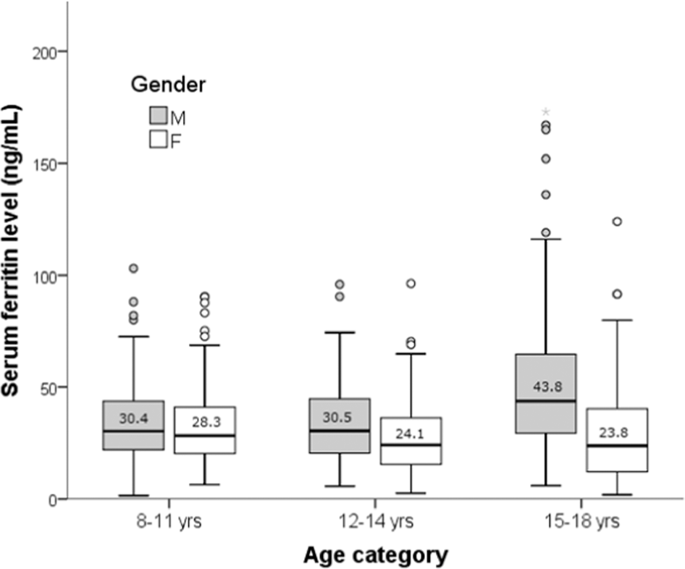当前位置:
X-MOL 学术
›
Eur. J. Clin. Nutr.
›
论文详情
Our official English website, www.x-mol.net, welcomes your
feedback! (Note: you will need to create a separate account there.)
Prevalence of Iron deficiency in Lebanese schoolchildren.
European Journal of Clinical Nutrition ( IF 3.6 ) Pub Date : 2020-03-03 , DOI: 10.1038/s41430-020-0590-y Ralph El Khoury 1 , Ghassan Sleilaty 2 , Marie-Hélène Gannagé-Yared 1
European Journal of Clinical Nutrition ( IF 3.6 ) Pub Date : 2020-03-03 , DOI: 10.1038/s41430-020-0590-y Ralph El Khoury 1 , Ghassan Sleilaty 2 , Marie-Hélène Gannagé-Yared 1
Affiliation

|
BACKGROUND
The prevalence of iron deficiency in the Lebanese pediatric population is unknown. The aim of this study is to estimate this prevalence in Lebanese schoolchildren and to assess the relation between iron status and related factors.
SUBJECTS/METHODS
A total of 903 children aged 8-18 years (466 boys and 437 girls) were included in the study. Recruitment was done from ten schools with different SES levels and located in the Great Beirut and Mount Lebanon areas. Serum ferritin was measured in all participants and testosterone was measured only in boys using Immulite chemiluminescent assays.
RESULTS
For the entire sample, the median serum ferritin concentration was 30.0 [19.8-44.8] ng/mL and the prevalence of iron deficiency (ferritin < 15 ng/mL) was 14.2%. Iron deficiency was higher in girls compared with boys (respectively, 20.8% and 7.9%). This prevalence varied with the SES (respectively, 11.6%, 11.9%, and 16.8% in high, middle, and low SES, p = 0.09). Iron deficiency increased with age (9.5%, 15.7%, and 17.5%, respectively, for the age groups 8-11, 12-14, and 15-18, p = 0.014) and did not differ between normal, overweight, and obese groups (p = 0.07). In boys, a significant positive correlation was observed between ferritin and total testosterone (rho = 0.150, p = 0.001).
CONCLUSION
The prevalence of iron deficiency is relatively low in Lebanon. Younger boys, menstruating girls, and children from low SES are more prone to iron deficiency, while BMI has no impact.
中文翻译:

黎巴嫩学童中铁缺乏症的患病率。
背景技术在黎巴嫩小儿人群中铁缺乏症的患病率尚不清楚。这项研究的目的是评估黎巴嫩学龄儿童的患病率,并评估铁状况与相关因素之间的关系。受试者/方法研究共纳入903名8-18岁的儿童(466名男孩和437名女孩)。招聘是从位于大贝鲁特和黎巴嫩山地区的10所具有不同SES水平的学校进行的。使用Immulite化学发光测定法对所有参与者进行血清铁蛋白测定,仅对男孩进行睾丸激素测定。结果对于整个样本,血清铁蛋白的中位数浓度为30.0 [19.8-44.8] ng / mL,铁缺乏症(铁蛋白<15 ng / mL)的患病率为14.2%。女孩的铁缺乏症比男孩高(分别为20.8%和7。9%)。该患病率随SES的变化而变化(高,中和低SES分别为11.6%,11.9%和16.8%,p = 0.09)。铁缺乏症随年龄增加而增加(8-11岁,12-14岁和15-18岁年龄组分别为9.5%,15.7%和17.5%,p = 0.014),正常,超重和肥胖之间无差异组(p = 0.07)。在男孩中,铁蛋白和总睾丸激素之间存在显着正相关(rho = 0.150,p = 0.001)。结论黎巴嫩的铁缺乏症患病率较低。SES较低的男孩,经期女孩和儿童更容易缺铁,而BMI则没有影响。对于8-11、12-14和15-18岁年龄组,p = 0.014),正常,超重和肥胖组之间无差异(p = 0.07)。在男孩中,铁蛋白和总睾丸激素之间存在显着正相关(rho = 0.150,p = 0.001)。结论黎巴嫩的铁缺乏症患病率较低。SES较低的男孩,经期女孩和儿童更容易缺铁,而BMI则没有影响。对于8-11、12-14和15-18岁年龄组,p = 0.014),正常,超重和肥胖组之间无差异(p = 0.07)。在男孩中,铁蛋白和总睾丸激素之间存在显着正相关(rho = 0.150,p = 0.001)。结论黎巴嫩的铁缺乏症患病率较低。SES较低的男孩,经期女孩和儿童更容易缺铁,而BMI则没有影响。
更新日期:2020-04-24
中文翻译:

黎巴嫩学童中铁缺乏症的患病率。
背景技术在黎巴嫩小儿人群中铁缺乏症的患病率尚不清楚。这项研究的目的是评估黎巴嫩学龄儿童的患病率,并评估铁状况与相关因素之间的关系。受试者/方法研究共纳入903名8-18岁的儿童(466名男孩和437名女孩)。招聘是从位于大贝鲁特和黎巴嫩山地区的10所具有不同SES水平的学校进行的。使用Immulite化学发光测定法对所有参与者进行血清铁蛋白测定,仅对男孩进行睾丸激素测定。结果对于整个样本,血清铁蛋白的中位数浓度为30.0 [19.8-44.8] ng / mL,铁缺乏症(铁蛋白<15 ng / mL)的患病率为14.2%。女孩的铁缺乏症比男孩高(分别为20.8%和7。9%)。该患病率随SES的变化而变化(高,中和低SES分别为11.6%,11.9%和16.8%,p = 0.09)。铁缺乏症随年龄增加而增加(8-11岁,12-14岁和15-18岁年龄组分别为9.5%,15.7%和17.5%,p = 0.014),正常,超重和肥胖之间无差异组(p = 0.07)。在男孩中,铁蛋白和总睾丸激素之间存在显着正相关(rho = 0.150,p = 0.001)。结论黎巴嫩的铁缺乏症患病率较低。SES较低的男孩,经期女孩和儿童更容易缺铁,而BMI则没有影响。对于8-11、12-14和15-18岁年龄组,p = 0.014),正常,超重和肥胖组之间无差异(p = 0.07)。在男孩中,铁蛋白和总睾丸激素之间存在显着正相关(rho = 0.150,p = 0.001)。结论黎巴嫩的铁缺乏症患病率较低。SES较低的男孩,经期女孩和儿童更容易缺铁,而BMI则没有影响。对于8-11、12-14和15-18岁年龄组,p = 0.014),正常,超重和肥胖组之间无差异(p = 0.07)。在男孩中,铁蛋白和总睾丸激素之间存在显着正相关(rho = 0.150,p = 0.001)。结论黎巴嫩的铁缺乏症患病率较低。SES较低的男孩,经期女孩和儿童更容易缺铁,而BMI则没有影响。











































 京公网安备 11010802027423号
京公网安备 11010802027423号